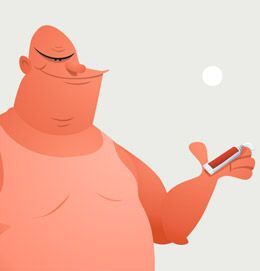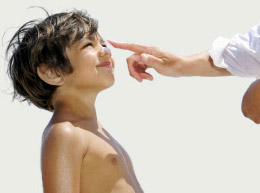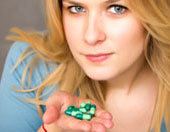Sun safety tips: How to guard against the sun's damaging UV rays

Posted in General Health & Wellness on September 17, 2011 by NebraskaHealth.com staff. Last modified on April 21, 2019. Read disclaimer.
We love the sun -- but it doesn't always love us back. In any season of the year there are health consequences to too much sun exposure: eye damage such as cataracts, skin wrinkling and premature aging, immune system suppression, and the biggest one, skin cancer. Over one million Americans are newly diagnosed with skin cancer each year and most of these could have been prevented.
Who is most at-risk for sun burns, skin cancers and other sun related health concerns?
While everyone, regardless of skin color, ethnicity, or age can suffer sun related eye and skin damage, you are especially vulnerable if you:
- spend a lot of time in the sun or have been sunburned.
- have light-colored skin and hair.
- blue, green or hazel, eyes.
- have a history of many moles, freckles or severe burns.
- spend a lot of time indoors and spend time outdoors only infrequently.
- have certain autoimmune diseases.
- are taking medications, vitamins, herbs or certain OTC drugs that increase sensitivity to sunlight.
- or have a family member with skin cancer.
are photosensitive (highly sensitive to sunlight)
+ Free Shipping & Returns on Eligible Items.
(*Amazon's Top 100 list updated hourly.)
The good news is that you can enjoy the sun and still take care of your health by following all or a combination of these tips. Remember, don't rely on any ONE of them to provide full sun protection by itself.
Use sunscreen: The sun's UV rays can damage skin in as little as 15 minutes -- regardless of whether the day is sunny or cloudy ![]() (up to 80% of UV rays pass through clouds). So apply one ounce or a full palm of sunscreen (that's enough to cover the average body) to dry skin 20-30 minutes BEFORE going outside. Choose a sunscreen with a sun protection factor (SPF) of at least 15 -- the higher the number, the greater the protection is likely to be. And be sure to re-apply if you're out in the sun for more than two hours, and after you swim or do things that make you sweat. Lastly, be mindful of your sunscreen's expiration date. Sunscreens are formulated to remain stable and at full strength for 3 years.
(up to 80% of UV rays pass through clouds). So apply one ounce or a full palm of sunscreen (that's enough to cover the average body) to dry skin 20-30 minutes BEFORE going outside. Choose a sunscreen with a sun protection factor (SPF) of at least 15 -- the higher the number, the greater the protection is likely to be. And be sure to re-apply if you're out in the sun for more than two hours, and after you swim or do things that make you sweat. Lastly, be mindful of your sunscreen's expiration date. Sunscreens are formulated to remain stable and at full strength for 3 years.
Protect your lips: Just like sunscreen, your lip balm should provide a minimum of SPF 15 protection.
Cover up: Loose-fitting, long-sleeved shirts and long pants made from tightly woven fabric protect best from UV rays. If you're especially concerned about sun damage, look for clothing that has an SPF factor. At minimum, wear a t-shirt or beach cover-up after swimming.
Hats on to safety: Protect your face, ears, and the back of your neck with a hat that features a brim all the way around. Straw hats with holes that let sunlight through won't do much to block UV rays; a darker-colored hat may help more than a light-colored one.
Wear shades: Sunglasses don't just look cool, they work well to protect your eyes from UV rays and reduce the risk of cataracts. Wrap-around styles work best because they block rays from leaking in from the sides. Darker shades are not necessarily better. UV protection comes from an invisible chemical applied to the lens and not from the lens shade or darkness. Children need REAL, not toy, sunglasses!
Put time on your side: The hours between 10 a.m. and 4 p.m. daylight savings time are the most dangerous for UV exposure in the continental U.S. During those hours, try to stay in the shade, and be sure to use sunscreen or wear protective clothing.
Be extra careful around water, snow, concrete and glass: All of these reflective surfaces can magnify the strength of damaging UV rays.
Avoid tanning salons: Artificial radiation exposes you to the same dangers as real sun exposure.
No sun for baby: Avoid exposing infants to direct sunlight. Sunscreen should not be applied to infants, 6 months or younger.
Become familiar with your moles, blemishes, freckles, etc., and check your skin monthly for any changes: Pay special attention to face, ears, lips, nose and other often overexposed areas. Be especially watchful for:

- red patches or or pink, red, or white shiny bumps or sores that won't heal. These may be possible signs of basal cell carcinoma skin cancer.
- dark brown or black mole-like patches with irregular edges may be signs of melanoma skin cancer.
 Most Popular Topics:
Most Popular Topics:
 Feeling blah? Boost your mood
Feeling blah? Boost your mood Tips for making fitness fun
Tips for making fitness fun Preparing for retirement
Preparing for retirement Summer heat safety tips
Summer heat safety tips Keeping your teeth in tip-top shape
Keeping your teeth in tip-top shape What are the nutritional needs of children?
What are the nutritional needs of children? Tips for preventing sunburns
Tips for preventing sunburns How to cook dried beans
How to cook dried beans Slow cooking beans in a crock pot
Slow cooking beans in a crock pot Medication safety tips
Medication safety tips Why are food allergies becoming so common?
Why are food allergies becoming so common? Foods associated with romance
Foods associated with romance